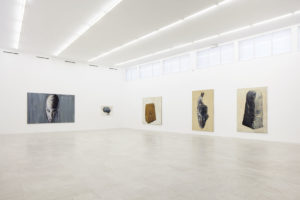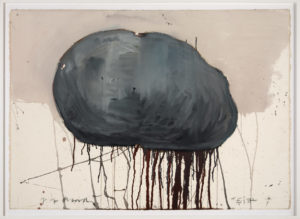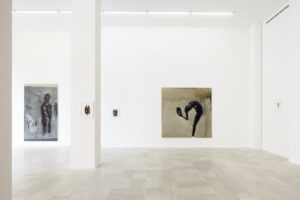Piero Manai (Bologna, 1951-1988) is one of the most enigmatic figures in contemporary painting, a solitary and tormented artist who, as Umberto Eco wrote in 1991, “after Giorgio Morandi was continuing the discourse of the great Bolognese painting”. He died at the age of 37 leaving an extraordinary body of works and the regret of not being able to see where his artistic discourse would have landed if he had had the opportunity to develop it further. In two decades of tireless research, the artist experimented with different figurative techniques – from drawing, to oil painting, to photography – initially orienting himself towards a hyper-realistic and pop figuration and then flowing into a restless gesture that led him to tear the image and to reproduce it in an almost sculptural sense.
The psychophysical tension of painting in the last period originates in an almost demonic conception of life and is influenced by the Central European expressionism which in those years emphasized corporeality as a vehicle of immediacy and intensity. The themes of trauma, sexuality and death meet here with a stubborn reflection on painting in order to create an impossible symbiosis between objectivity, individuality and abstraction. And it is precisely this lucid fixation which avoids irreversible dismemberment and dissolution in the depths of the unconscious in all his work, identifying a principle of original unity that makes the form survive the gestural mutilation. One could speak of his instinctive reliance on the tangibility and consistency of color, which flows on the canvas in a free pictorial flow but always ends up aggregating in dense volumetric allusions.
The galleries P420 and CAR DRDE, in collaboration with the heirs of Piero Manai, present a joint exhibition until November 9th, the most complete after the great retrospective curated at the former GAM of Bologna by Peter Weiermair in 2004, dedicated to the last ten years of the artist’s production. The double exhibition, chronological and thematic, sees the human figure as protagonist in the gallery of Alessandro Pasotti and Fabrizio Padovani and the still life in that of Davide Rosi. The comparison between the two figurative genres, the main ones on which the artist has concentrated, brings out the coherence of his approach in dealing with the same pictorial object that seems to obsessively repeat itself in two complementary appearances.
The selection of works exhibited at CAR DRDE highlights the transition from the still lifes of the early 1980s, infinite variations on the theme of the classic Caravaggesque fruit basket conceived as open and energetic pictorial structures identified by brushstrokes that draw contours and light reflections, to the apparently quieter paintings of recent years, which depict compositions of abstract solids, no longer directly related to the appearances of reality. Here the tension of the image, finding no outlet in the liberating gesture of the rapid and nervous brushstroke, translates into a retained potential, almost on the point of imploding. Painting becomes consistent and stratified, volumetric allusions translate into sensations of gravity and weight, emphasized by a wholly mental light that hypnotizes the observer. There is no story or temporality, solids impose themselves on the gaze as a material of representation that synthesizes visions, symbols and meanings. In particular, the solid ovals, extreme condensations of the fruit or stone, are at the same time ancestral heads and “weights”, those very peculiar burdens of Manai that all his creatures are destined to carry, while the basic parallelepipeds, his characteristic “monoliths” could be degenerated bodies, walled alive in painting.
These compositions are the most exciting link between the object and the body and lead us to the works on display at P420, which show the parallel evolution of the painter in the interpretation of the human figure. In chronological order, we start from the “flayed” of the early 1980s, which present man as a complicated frame of brushstrokes that summarize muscles, bones and existential conditions. Each character appears intent on his solitude, aggravated by the frequent presence of “doubles” that intensify his discomfort, in a mutual and desperate mirroring. At times only the head remains, deprived of physiognomic traits, that exhibits more eloquent disintegrations and deformations than any expressionism. The psychic substance results in labyrinthine tangles of brushstrokes that do not lead to any center and that sometimes flow outside the confines of the figure to spray the background.
Over the years this physical and mental complexity acquires a powerful monumentality, due both to the large dimensions of the canvases and to the thickening of the pictorial material in fused and substantial brushstrokes. The figure tries to protect itself, folds up and locks itself in until it even loses the most elementary grips of recognition and becomes a stone, a parallelepiped with rounded corners or a stele enigmatically surrounded by a neutral background. An intermediate phase of this transmutation could be identified in the oil on plastic series entitled Figure in the landscape (1987), in my opinion, the most moving sequence of the whole exhibition for its bare simplicity. In this succession of small-format paintings we see painful human shapes crouched in a fetal position suspended in the void like flowers, with the only support of a faint stem of pictorial matter expelled by an invisible orifice.
Manai considered his subjects as a kind of self-portraits seen from within, like anatomical and psychic constructions that “put a strain on the figure to reach a threshold”. In confirmation of this interpretation, in both galleries we find precious examples of Polaroids in which the artist, intervening on the film during the time of exposure or after the print with pictorial interventions, self-portrayed deforming his image in the intimacy of a solitary exhibitionism.
Info:
Piero Manai
27 September – 09 November 2019
P420
Via Azzo Gardino 9 Bologna
CARDRDE
Via Azzo Gardino 14/a Bologna
 Piero Manai, exhibition view at CAR DRDE
Piero Manai, exhibition view at CAR DRDE
 Piero Manai, Natura morta, 1988, oil on paper mounted on canvas, 60×60 cm courtesy CAR DRDE
Piero Manai, Natura morta, 1988, oil on paper mounted on canvas, 60×60 cm courtesy CAR DRDE
 Piero Manai, exhibition view at P420
Piero Manai, exhibition view at P420
 Piero Manai, Testa, 1985, olio su carta intelata/oil on paper mounted on canvas, cm.75×105 courtesy P420
Piero Manai, Testa, 1985, olio su carta intelata/oil on paper mounted on canvas, cm.75×105 courtesy P420
 Piero Manai, exhibition view at P420
Piero Manai, exhibition view at P420
Graduated in art history at DAMS in Bologna, city where she continued to live and work, she specialized in Siena with Enrico Crispolti. Curious and attentive to the becoming of the contemporary, she believes in the power of art to make life more interesting and she loves to explore its latest trends through dialogue with artists, curators and gallery owners. She considers writing a form of reasoning and analysis that reconstructs the connection between the artist’s creative path and the surrounding context.






NO COMMENT